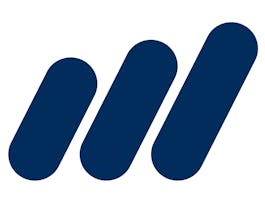This course is part of a Specialization titled “Strategy and Finance for a Lifecycle of a Social Business”, with a follow-on project-based course on understanding and evaluating a business focused on addressing a societal issue. The beauty of a modern decision-making framework is that it can be used to understand value creation at any level – the individual or business or societal. The applications however become increasingly complex as your lens expands from the individual to the corporate/nonprofit to the global society.



Risk, Return and Valuation
This course is part of Strategy and Finance for the lifecycle of a Social Business Specialization


Instructors: Suresh K. Krishna
Sponsored by Barbados NTI
Recommended experience
What you'll learn
How to value projects and companies
Skills you'll gain
Details to know

Add to your LinkedIn profile
6 assignments
See how employees at top companies are mastering in-demand skills

Build your subject-matter expertise
- Learn new concepts from industry experts
- Gain a foundational understanding of a subject or tool
- Develop job-relevant skills with hands-on projects
- Earn a shareable career certificate


Earn a career certificate
Add this credential to your LinkedIn profile, resume, or CV
Share it on social media and in your performance review

There are 6 modules in this course
The Specialization is part of a program designed for an audience interested in working for, or creating, social businesses and anyone who wants to use modern frameworks and tools to understand how value is created for an individual, a company and social business. Since social businesses take on inherently more complex missions - by design, they are set up to address social issues - the task of understanding and evaluating opportunities aimed at addressing social issues requires a deeper understanding of the strengths and weaknesses of modern frameworks and tools. Arguably, all businesses try and impact society. This is the main reason why the Specialization has both analytical rigor and real-world applicability. My hope is that by the end of the Specialization we will be ready to evaluate, understand, and even create social businesses. This is a journey that will start with value to an individual and then gradually understand value created by regular businesses and, finally, tackle value creation by a social business. We will however not wait till the end of the Specialization to start thinking seriously about how social businesses are distinct from regular businesses. The good news is that you have already been exposed to a great course on social business – with world-known experts sharing their views, followed by an engaging and framework-based approach to consider how to identify a social problem and then develop an approach to addressing it using a multi-stakeholder approach. To motivate folks to understand the complexity of evaluating a social business, I will start by sharing some publicly available articles on what popular thinking is about social business, on how to measure social value and some real-world examples. I will do so gradually over the four courses, without testing, but with reflection exercises built in at the beginning and the end of each course. I have managed the Social Venture Fund (SVF) at the University of Michigan for over a decade now and we evaluate and invest in social businesses. I also recently launched the International Investment Fund (IIF) in India that evaluates, supports and invests in small- and medium-sized businesses. I will share cases written by me and my students related to this work, but please do not distribute them. The purpose of the reflection exercises is meant for you to gradually gain exposure to the complexities of social businesses and measuring social value. You are not expected to be able to value the businesses described in the cases, but to keep them in mind and reflect on the frameworks and tools you are introduced to and their applicability to decision-making in social businesses. While you will not be tested on specifics in the reflection portions of this Specialization, maintaining a personal journal on important issues throughout the Specialization will really help so you prepare for the challenging work on the project on a social business following successful completion of the Specialization. You will hopefully realize that the framework and tools provided in the Specialization will not only help you in any business, but also are the same for a social business. You will hopefully realize that, at the end of the day, it is all about intent and what you produce/provide and to whom and how. And what is readily measurable and verifiable may be one of the key differences between a regular and a truly social business – everything, eventually, is about quantity times price of what you have to offer. Most businesses focus on producing goods and services that have readily available markets and therefore prices. Perhaps the key difference in understanding and managing a social business versus a regular business is its focus on issues beyond an individual and a desire to provide goods and services that are not priced and therefore rewarded by free markets because they benefit society and cannot be captured by corporations. This, in turn, makes a social business all the more challenging to create and manage.
What's included
2 readings
This module contains detailed videos and syllabi of both the Specialization and the fourth course. This Specialization has been designed to enable you to learn and apply the powerful tools of modern finance to personal, corporate and social businesses. In fact, this frameworks and tools can be applied to decision-making in any context, including nonprofit and governmental initiatives to tackle the simplest to most challenging issues we confront individually or collectively. The courses within progress linearly and build on each other and it is important for you to get an understanding of why this Specialization may be relevant to any context. Please review the videos and syllabi as they will give you a sense of the Specialization and how this specific course fits within. My teaching style and philosophy are also presented to you (hopefully) in sufficient detail. I believe education is the key to addressing the challenges that we face across the globe. Most importantly, all this content is meant to give you enough information to enable you to make a decision about whether you want to take this Specialization, or this course by itself. To make sure you have the social lens in mind, we have also created a course that focuses on social business that you must take before this Specialization. This will hopefully make you think about what a social business looks like and, importantly, how it differs from standard business. A deeper realization of this can only occur when you are able to recognize how value is created by regular businesses. This will be a slow process that is hopefully already in motion and your understanding will deepen by the end of this course so that you are ready to work on a social business.
What's included
5 videos1 reading
This course deals with the determination of the discount rate we have used in all previous courses to value projects, bonds and stocks. Combined with cash flows, the discount rate captures all aspects of financial valuation that is the main goal of this Specialization and course. In the first module, we will try and understand risk as perceived by humans and develop a measure that is powerful and intuitive. Since this topic requires both art and science of finance, we will have three assignments in this course.
What's included
8 videos4 readings2 assignments
During this module, we will introduce one of the most powerful and intuitive model of modern finance - the Capital Asset Pricing Model (CAPM) - that forms the basis of our understanding of the relation between risk and return.
What's included
8 videos1 reading2 assignments
In this module, we will understand the discount rate in a world where a company has both equity ad debt. This will require us to evaluate the impact of debt (also known as leverage) on the equity holders of the firm. We will develop the weighted average cost of capital. Finally, we will put together cash flows and WACC and get our first exposure to valuation with a full-blown application.
What's included
16 videos2 readings
This last module of this course and the Specialization. We therefore wrap things up by providing some real world twists and a final assignment that evaluates your ability to put everything together.
What's included
1 video3 readings2 assignments
Instructors


Offered by
Why people choose Coursera for their career




Recommended if you're interested in Business

University of California, Irvine

Corporate Finance Institute

New York Institute of Finance

University of Michigan

Open new doors with Coursera Plus
Unlimited access to 10,000+ world-class courses, hands-on projects, and job-ready certificate programs - all included in your subscription
Advance your career with an online degree
Earn a degree from world-class universities - 100% online
Join over 3,400 global companies that choose Coursera for Business
Upskill your employees to excel in the digital economy


